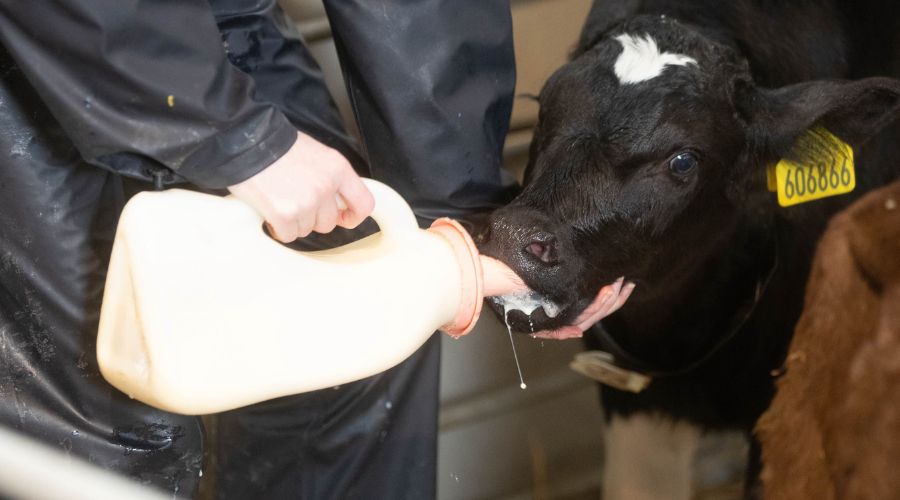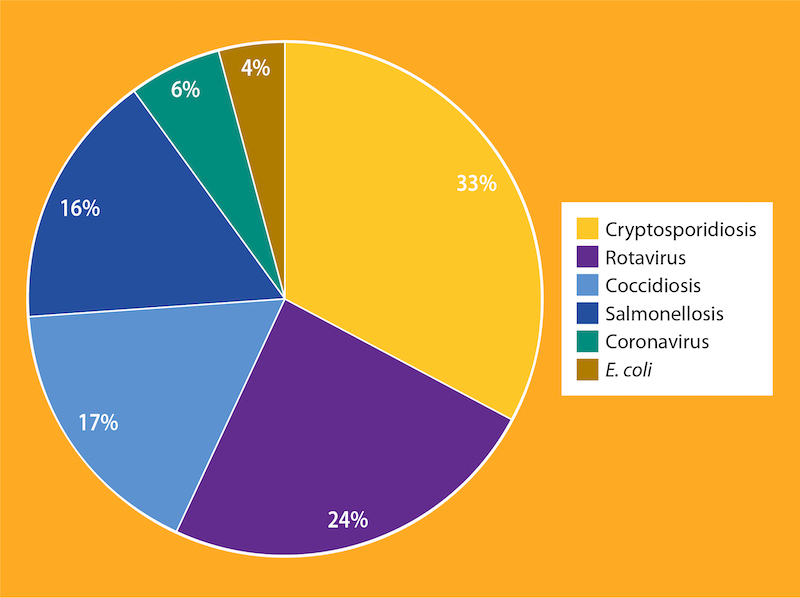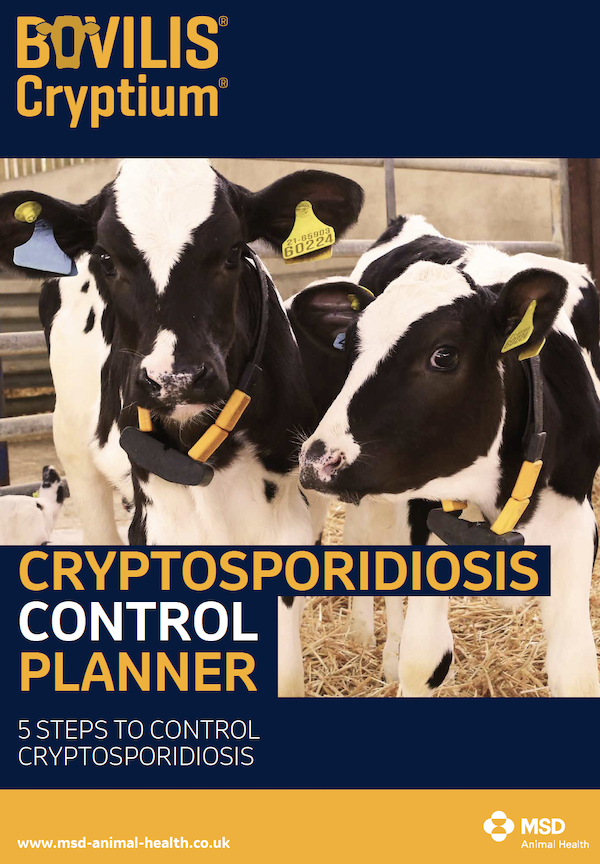Improved calf crypto control now within reach
26th September 2024
Improved control of calf cryptosporidiosis is now within reach, experts say, thanks to a new control plan and vaccination.

Cryptosporidium parvum is now the leading cause of scour in young calves, resulting in reduced growth rates and sale prices, as well as extra work, treatment costs and mortalities.
Calves with severe cryptosporidiosis in the first 16 days of life weigh 34kg less on average than low disease calves, equating to a loss of £161 in sale price, a recent study found.
Even those with mild clinical disease weigh less and the difference does not even out.
Additionally, survey work highlighted the mental health toll on farmers, with respondents saying it reduced the joy in their work and made them dread calving time.
C parvum is also zoonotic, with research showing a significant proportion of cases come from animals, especially in spring.
For the first time, a C parvum vaccine for late pregnancy heifers and cows was licensed for use in August.
MSD Animal Health has also launched a five-point scour control plan for farmers, covering diagnosis, colostrum management, environment and management, prevention and treatment.
The five-point control plan
Farmers and vets can work through five questions under each of the five sections and pinpoint areas needing attention. An action plan can then be discussed and implemented.
1. Diagnosis
Identifying the cause of scour is important as treatment approaches differ depending on the pathogens involved, advised Dr Kat Baxter-Smith, veterinary advisor for MSD Animal Health.
Rainbow calf scour testing kits, like ScourCheck, are simple and quick to use on farm and can identify C parvum, rotavirus, coronavirus or E. coli K99).
Your vet may recommend further testing to investigate coccidia and salmonella.

2. Colostrum
Dr Katie Denholm, an academic clinician at the University of Glasgow Veterinary School, said the five Qs of colostrum management are critical to giving calves the best immunity:
- Quality: >50g/L IgG in colostrum, <100,000 CFU/ml TBC, <10,000 CFU/ml TCC
- Quantity: 10-12% bodyweight in colostrum, 150-200IgG supplied
- Quickly: In the first 6 hours
- Quantify: >10g/l IgG in serum, >50g/L IgG in colostrum
- Quietly: Reduce stress, as cortisol impacts absorption of antibodies.
Meanwhile, extended colostrum feeding – beyond day one – is an emerging area of interest and research and offers a myriad of benefits for calf health and growth.
Dr Denholm stressed that colostrum provides so much more than just immunoglobulins to the calf.
“This liquid gold also contains immune modulators such as oligosaccharides, valuable enzymes, lactoferrin, cytokines, hormones, vitamins, and minerals – all of which are important for long term gut health, function and development.”
While a recent survey of 248 UK farmers revealed most would be open to extended colostrum feeding, supply and storage problems present challenges.
As it’s often difficult to harvest enough first milking colostrum to feed this alone in an extended way, transition milk is preferable for longer term feeding.
Artificial colostrum replacers and/or supplements are often inferior to maternally derived colostrum and may lack farm specific immunity, Dr Denholm added.
READ MORE: Cornish farmer crowned calf rearer of the year
READ MORE: Celebrating 10 years of UK Dairy Day
To keep colostrum and transition milk for longer, you can add chemical preservatives (e.g. 1% of a 50% potassium sorbate solution), or store at a low temperature.
“Depending on initial contamination levels, refrigeration at 4°C for 2-5 days and freezing in two litre batches at -20°C for up to 12 months will keep bacterial concentrations low and IgG concentrations high,” she said.
When you’re ready to use it, warm the frozen colostrum to around 40°C using hot water baths, not a microwave.
Additionally, colostrum should be harvested within six hours, as it deteriorates within the udder. Leaving in buckets before feeding to calves also risks creating a ‘bacterial soup’.
Ideas for supplementing colostrum:
- 2-3 large ice cubes of frozen first milking colostrum added to milk replacer feed. Provides 2.5 of antibodies, 30ml colostrum
- 40-70kg colostrum replacer added to MR feed. Provides 10g for five days
- Mix transition milk into pasteurised milk – Brix showed it provided 35g/L of IgG – an excellent amount
- Feed TM for 3-5 days
- Use milk replacer with plasma as part of protein profile.
3. Environment and management
Dr Baxter-Smith advised disinfecting the entrance to the calf shed, and having strict hygiene protocols for feeding equipment – daily cleaning and disinfection.
“Muck out, steam clean, disinfect and leave to dry as often as you practically can,” she said. “Many common farm disinfectants are not effective against C. parvum, so only use those that are licensed to control this pathogen. And leave disinfected pens to dry thoroughly because C. parvum does not like dessication.”
The following products have been proven to work against C parvum:
- 2-3% Keno Cox
- Neopredisan 135-1
- 10% Ox-Virin
- 3% hydrogen peroxide.
Sick calves should be isolated and kept warm and hydrated, and staff should work with healthy calves first, to avoid spreading disease. Never mix newborn calves with those older than 3-4 days.
Bedding must be replaced and replenished every 1-2 days, and feeding and drinking troughs should be raised at least 0.75m off the ground to prevent contamination.
READ MORE: NFU Scotland angry at Lactalis decision to drop dairy suppliers
READ MORE: Beef Shorthorns: Ticking the boxes for sustainable farming
4. Prevention
New vaccine Bovilis Cryptium is the first of its kind – no such vaccine is available even for humans, despite demand.
For the first pregnancy, dams need two doses 4–5 weeks apart, three weeks before calving. For subsequent pregnancies, only one booster 12-3 weeks prior to calving is needed. It’s recommended for whole herd use.
Once opened, the bottle can be stored in the fridge for up to 28 days.
The Bovilis Rotavec Corona vaccine also be given at the same time if needed. It boosts antibodies in colostrum for other important infectious scour pathogens; rotavirus, coronavirus and both E. coli F5 (K99) and F41.
Bovilis Cryptium is POM–VPS so it can only be administered by vets, not SQPs.
For immunity to be transferred to the calf, they will either need to feed entirely from the dam for five days, or, in the case of most dairy farms where calves are removed from the dam, supplemented with colostrum/transition milk from vaccinated dams.
This can be fed separately or added to usual milk replacer feed in the following quantities:
- Day 1: At least 3 litres of day one colostrum
- Day 2: At least 1 litre of day one colostrum
- Days 3-5: At least 0.5 litres of transition milk.
The new vaccine is currently only available to UK farmers with a special import licence but MSD will have UK stock from November.

5. Treat
Even where the previous four steps are implemented, it may still be necessary to treat individual calves where pathogen infectious pressure is very high.
Dr Baxter-Smith said: “Calves with diarrhoea are often dehydrated. Consequently, it is crucial to provide rehydration in the form of oral or intravenous fluids (in addition to the normal milk feed) – and, under veterinary guidance, pain relief and antibiotic treatment may also be required.”
Halofuginone lactate (e.g. Halocur) is the only licensed, non-antibiotic solution for the control of cryptosporidiosis in calves, she continued.
While primarily licensed for prevention, it can also be used for early treatment.
Farmers interested in the new five-step calf cryptosporidiosis control planner tool should contact their local MSD Animal Health account manager for further information.
Read more livestock news.
